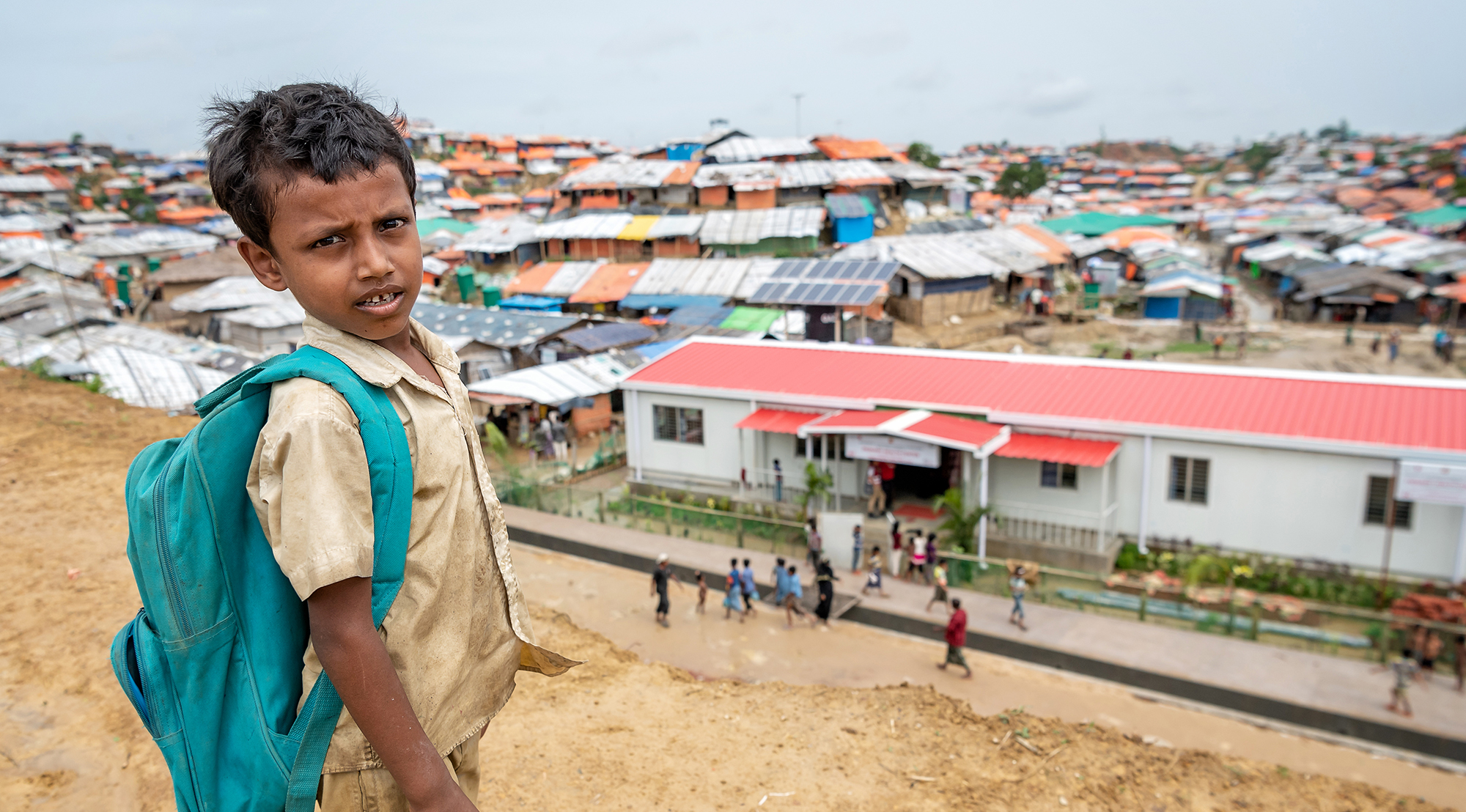A large number of displaced persons sought refuge in Bangladesh in 2017 from the violence in Myanmar. The Swiss Red Cross (SRC) has been active in Bangladesh for almost 50 years and has also been in Cox’s Bazar since 2017. In this interview, Benedikt Kaelin, Program Officer for Bangladesh at the SRC, talks about the lives of people in the camps and assesses how they can move forward.
It has been two years now since the Rohingya people fled from Myanmar. What is the situation in the camps today?
Almost a million people currently live in the camps, of whom over 700,000 have been living there since the events in August 2017. Some of them were already in Bangladesh before the exodus in 2017, but most of them arrived at the camps later. The camps are huge, and parts almost feel like a normal city. However, the government is taking care to ensure that no permanent infrastructure is built. The refugees in the camps live very closely to one another – in parts of the camp, this amounts to as little as 10m2 per person (while humanitarian standards envisage 30 – 45 m2) – and the lack of hygiene is also a problem.
Compared with two years ago, the situation has generally improved in many areas, for example, in terms of basic supplies and health care. The government, together with the UN Refugee Agency UNHCR, has given half a million people refugee papers, and many children have been able to go to school for the first time in their lives. The structures and coordination between different humanitarian organizations have also significantly improved.
The lack of future prospects, however, is becoming an ever-greater problem. The refugees have no access to the formal labor market and are dependent on humanitarian aid. Alongside the traumatic experiences that many people have lived through, this leads to ever-increasing desperation and destructive coping mechanisms.
Tension within the camps as well as between those in the camps and the local population is also increasing. Lots of land and resources, which had previously belonged to the local population, were required for the camps, and the sheer number of people is driving prices up. When a local politician in the region was murdered at the end of August 2019, young men from the camps were suspected of the crime, leading to angry protests by the local population.
Why are tension and violence increasing now even though the conditions in the camps have improved in many areas?
In relation to violence, this still only involves a number of individual instances, and I cannot see any pattern so far of rising violence in the camps themselves. When so many people live together in such precarious conditions, then, in my opinion, a certain amount of criminality and violence is almost unavoidable. But what is definitely increasing is tension between the local population and the camps’ inhabitants.
Reasons for this include the many expectations that are not being fulfilled as well as the lack of resources I mentioned earlier. Another reason is that these huge camps distort the local economy, and there are of course also people who are profiting from this: I’m thinking, for example, of hotels and transport companies or also people who have found a job with the international organizations. This distorted market, combined with the increasing realization that people are going to have to get used to the fact that the crisis will not be over soon, is causing a lot of frustration in some cases.
How close do the camps’ inhabitants and the local population live to each other? Do they see each other every day?
Yes, it is actually the case that people meet each other every day and live very close to one another. There are of course checkpoints at the entrance to the individual camps, however, the camp as a whole covers a very large area, with various local communities dotted about across the territory concerned. These encounters are often wholly positive. People meet each other at the market, and there is lively interaction. The markets in the camps are also functioning better and better because this interaction is actually helping viable supply chains to emerge.
You have said that camp inhabitants are not allowed to take on formal work. What do they do all day?
They are not allowed to work formally but smaller jobs that don’t require any proper qualifications are possible. Certain people are also compensated for this work. Some earn money through their work with the aid organizations. The refugees are on the look out for such opportunities, particularly the men, and they struggle when they don’t have anything to do. The men are often at the market all day long searching for a source of income. The women stay more often in their accommodation and look after their families.
Which services does the SRC offer on the ground?
The Swiss Red Cross is concerned with meeting current needs and mainly works in a health care capacity, where it can bring its expertise to bear. With this kind of work, you have to differentiate between the role at the beginning, which mainly involved emergency aid, and the situation now, which requires a more long-term view. Initially, the construction of toilets and standpipes was the focus, and hygiene training was carried out. In 2018, three multifunctional health centers were built in which the SRC has since been offering health and nutrition-related services in cooperation with partner organizations, helping bring families together and offering protection: the focus here is on family planning, vaccinations and hygiene measures. There are also offers of psychosocial support. Over 200,000 people have made use of these services so far.
The SRC is currently supporting the construction of two further health centers and is working closely on this with different actors and the Ministry of Health. The coordination at Red Cross health centers is unique because all these actors work under the same roof – NGOs, UN organizations and doctors from the government. Another special feature is how health centers are made from a special construction material: they are semi-permanent. Indeed, these are not built for the long term because the government would not allow this, but they are more stable than other buildings you might find in a camp.
In one of the camps, the SRC is also working on establishing a waste disposal system.
What then are the biggest challenges in terms of the work on site?
As a member of the International Federation of Red Cross and Red Crescent Societies, the SRC works in its program countries, wherever possible, with local Red Cross societies. In Cox’s Bazar, this involves the Red Crescent of Bangladesh. This organization, like many other organizations, was ill prepared for the unusual situation in Cox’s Bazar. The SRC always therefore supports the structures of partner organizations through its projects, which can sometimes be a challenge. For example, our partner organizations can hardly match the high wages that other organizations pay their local employees – which makes it difficult in turn to find good people for the demanding work involved.
Another difficulty is the availability of government doctors. In particular, the journey to the camps can be very difficult, particularly during the rainy season, and this often leads to a lack of capacity.
How is work with the government in Bangladesh going?
The government has demonstrated great generosity in accepting the refugees. It continues to show the same spirit of generosity, and the SRC’s cooperation with the authorities is generally running very smoothly. For example, an agreement with the Ministry of Heath was signed recently, which defines the roles and responsibilities of the actors involved and obliges them to show constructive cooperation.
The challenges for Bangladesh as a host country, however, are enormous. Bangladesh is densely populated and, with 160 million inhabitants, has considerable needs of its own to meet. The situation in the refugee camps is therefore an additional burden.
A permanent settlement for refugees in Cox’s Bazar is not an option for the government – it is therefore planning to resettle the refugees onto an outlying island. This project is slowly taking shape. However, only some of the refugees could be resettled – approximately 150,000 people. According to the government, anyone who is at particular risk of natural disasters should be resettled in the first instance.
Can you tell us any more about these natural disasters? How real is this threat?
Bangladesh is a country that is repeatedly affected by natural disasters. First and foremost is the threat of monsoon, which has also caused great damage this year. From April until September, there were floods in the camps, which made it difficult to access services. Around 15,000 people were evacuated, and accommodation was damaged or destroyed. The settlements are built on slopes and can easily slip down. Thankfully, nobody died this year in the camps. This is partly down to the excellent safety measures put in place.
The camps are well prepared for smaller incidents. If a cyclone (for example) were to hit the area, however, this would have unforeseeable consequences.
What will the future bring?
In principle, there are three scenarios: repatriation of the refugees to Myanmar, some kind of resettlement or long-term settlement and integration at Cox’s Bazar. As already mentioned, the last scenario appears not to be an option for the government.
Talks are underway regarding repatriation. However, the positions of the countries involved and that of the United Nations regarding this matter are some way apart, and up to now, no refugees have volunteered to return. Also, both security and living conditions in Myanmar need to be guaranteed to a certain level.
So that leaves resettlement within Bangladesh: this could mean that 150,000 people are actually resettled, but this would still only account for a small proportion of the people concerned. What happens with the rest would remain to be seen.


